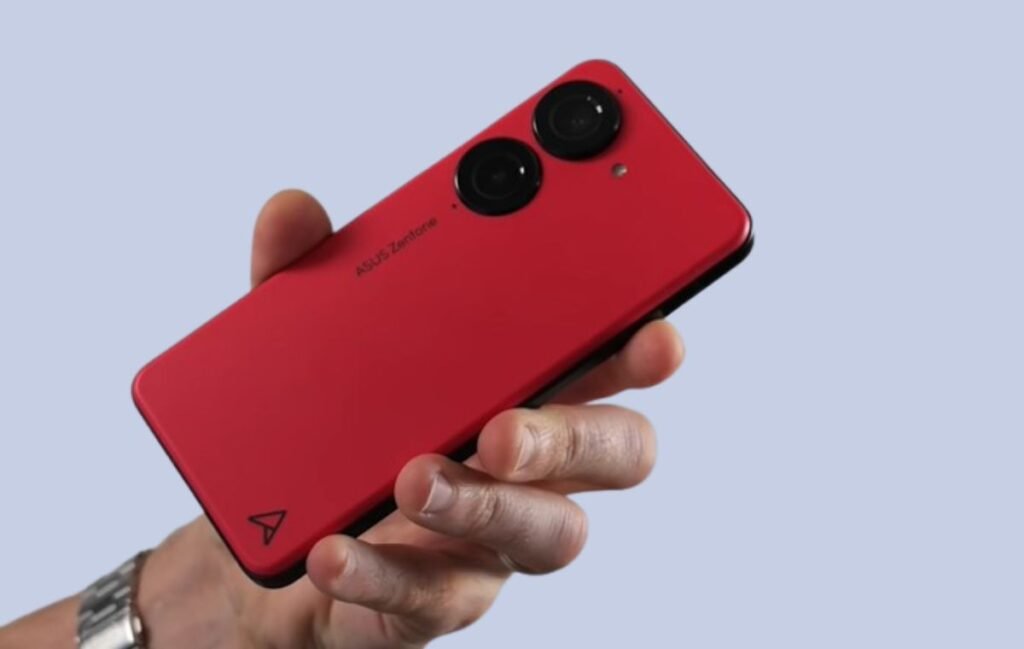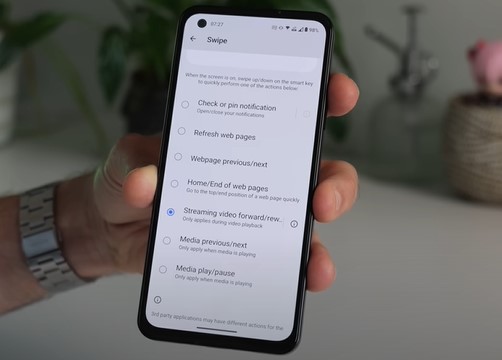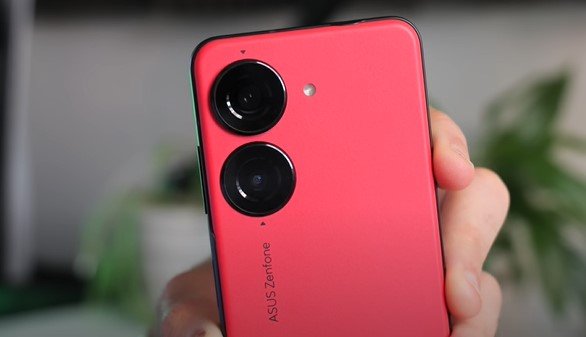The Asus Zenfone 10 is absolutely, hands down, one of my favorite smartphones of 2023, starting at $799, which is quite reasonable for a high-end device. It poses strong competition for the Pixel 7, the OnePlus 11, and other flagships. I’ve been using it as my full-time smartphone for two weeks, and here’s my full review.
Inside the box?

Inside the box, along with the Asus Zenfone 10, you’ll find an Asus power adapter, a USB cable, and Asus has also included a protective case. Just to clarify, it’s not a transparent case and it’s of the rigid type.
Design and Build Quality

The Asus Zenfone 10 is a compact smartphone with a 5.9-inch display, making it one of the smallest mobiles of 2023. Compared to other favorites like the Pixel 7A and the Xiaomi 13, it’s comfortably smaller. If you’re tired of dealing with larger 6.5-inch devices, this phone is your salvation. It’s incredibly lightweight, weighing just 170 grams.

The front of the Asus Zenfone 10 boasts thin bezels surrounding the compact display, which is quite impressive. On the back, you’ll find a bio-based polycarbonate surface that’s more environmentally friendly than its predecessor. Its texture is a bit of a puzzle, though, as it gives a soft-touch feel when grasped but feels somewhat cardboard-like when stroked.
Asus hasn’t made significant changes to the aesthetics, but that’s perfectly fine. I personally loved the look of the Zenfone 9, with its distinctive and clean design. The camera lenses, once again, stare at you like a pair of colds. They slightly protrude from the back, causing a bit of a wobble when placed on a desk.
The Asus Zenfone has five color options to choose from, including black, white, blue, a fresh Aurora green model, and a bold red one, which happens to be my favorite. It demands attention without compromising on any aspect.
The front has Gorilla Glass Victus protection, and after two weeks of use, I’ve only noticed one small scratch, while the metal frame and back remain in perfect condition. And as expected from a flagship device, the Asus Zenfone 10 is IP68 water and dust resistant, providing added peace of mind.
Read Also: ASUS Zenfone 10 vs Galaxy S23 Comparison
Zen UI and Features

Like all flagships, the Asus Zenfone 10 runs on Android 13, soon to be upgraded to version 14. Asus promises two OS upgrades and four years of security updates, which is respectable but falls short compared to rivals like Google, OnePlus, and Samsung that offer more OS updates. However, you can use this phone for a good three to four years without worrying about malware and other issues.

As far as UI, you have the option to choose a completely stock Android UI or go with Asus’ modified version. Even with the modifications, it remains quite close to stock compared to other big competitors like Samsung OneUI and Xiaomi’s MIUI, with some additional bonus features added on top. For example, you can swipe or tap the edge-mounted fingerprint sensor to perform various actions.
Asus has included a few other extras, such as a dedicated gaming mode. As for storage, you can get up to 512GB of space for your media, apps, and more. It will take me a while to fill that up. The Zenfone 10 doesn’t support expanding the storage with a microSD memory card. However, the SIM tray does have space for two SIM cards, in case you need them.
Display

The Asus Zenfone 10 has a 5.9-inch AMOLED panel by Samsung, offering a Full HD Plus resolution and 445 pixels per inch. The results are pleasingly crisp visuals. As expected from flagship devices, the colors pop, the blacks are deep, and the contrast is excellent. I have no complaints regarding the display.
And in terms of brightness, the auto brightness feature performed perfectly, and even at maximum brightness, I had no issues with visibility when using the phone outdoors, even on a bright sunny day. It’s important to note that it’s not an LTPO display, but the refresh rate can switch between 60Hz, 90Hz, 120Hz, and even up to 144Hz for supported games. Additionally, it can drop down to 30 FPS for the always-on display feature.
Audio
The Zenfone 10 features a stereo speaker setup. Its speakers may not be the most powerful, considering their compact size. However, all things considered, it really goes for it. At maximum volume, the entire phone rumbles vigorously, and you can feel the vibrations in your hands. It’s just about loud enough to hear clearly in noisy environments, and the clarity remains pretty good even at maximum volume.
And it also comes with a headphone jack at the top. So, if you’re looking for a flagship smartphone with a headphone jack, you have the choice of the Zenfone 10 or the Sony Xperia 1 Mark V. Additionally, for your Bluetooth streaming needs, it’s supporting aptX lossless, high-res audio, and more, just like last year. You can enjoy excellent audio quality with supported headphones or earbuds.
If you consider yourself an audiophile who likes to tweak and fine-tune the sound, you’ll have fast access to the Direct Virtual Audio Wizard in the notifications panel, offering a handy equalizer. Otherwise, leaving it on the dynamic setting automatically adjusts the sound to suit your activities.
Performance and Gaming

The Asus Zenfone 10 boasts the Qualcomm Snapdragon 8 Gen 2 chipset and has up to 16GB of RAM. The everyday experience is smooth, and you won’t have any worries if you want to indulge in some gaming during your spare time.
Although the 5.9-inch display might not be the ideal choice for mobile gaming, especially if you spend a lot of time hunched over the phone playing games like Call of Duty or PUBG, I personally enjoyed my time playing Genshin Impact on the Zenfone 10.
Even on the highest detail settings, the frame rates remained nice and fluid, with only a few minor jitters. It was nothing significant at all. Additionally, even if you’re completely absorbed in bashing enemies with a massive club, you won’t have to worry about overheating.
As expected from the makers of the ROG Phone, Asus has included a dedicated gaming mode. You can quickly open the Game Genie menu at any point with a quick swipe from the camera. The Game Genie menu is packed with all kinds of great tools, including various performance modes, notification blockers, and resource management options. You can even track the performance with on-screen stats, providing a comprehensive gaming experience.
Battery life
The Asus Zenfone 10 boasts a 4,300mAh battery, which is the same capacity as last year Zenfone 9. However, if you recall, the Zenfone 9’s battery life was actually pretty decent. The good news continues with the Zenfone 10, as somehow the battery life seems to have improved even further. I attribute this to the fantastic Snapdragon 8 Gen 2 platform.
You can expect around seven to eight hours of full-on screen time from a single charge, even with mixed use involving camera play, video streaming, and some gaming. I never once managed to drain the Zenfone 10 battery in a single day before heading to bed. In fact, with conservative use, it’s possible to go for a full couple of days without needing to recharge.
Speaking of recharging, it supports 30W wired charging, so it’s not the fastest in terms of charging speed. However, it comes with scheduled charging, steady charging, and other smart charging features.
That means you can plug in a cable overnight without worrying too much about overcharging the battery. Moreover, one of the omissions from last year’s Zenfone 9 was wireless charging. Thankfully, that’s not the case with the Zenfone 10. Asus has equipped it with full wireless charging support, as you would expect from a flagship phone in 2023.
Cameras Test

Asus has opted for Sony’s reliable 50-megapixel IMX766 sensor for the primary shooter, enhanced with improved six-axis gimbal stabilization. which means the entire camera module can compensate for any hand shake. The Asus camera app is user-friendly, allowing you to simply point and shoot, though there are a few toggles and options to explore. A quick double-tap of the power button loads the camera swiftly.

The Zenfone 10 meticulously processes each shot, individually rendering elements. In well-lit conditions, you’ll get bright and well-balanced HDR shots. Darker areas may appear lighter than in real life, affecting the atmosphere but offering more visible details without oversaturating the beautiful blue skies. Vibrant subjects are accurately captured, and the colors are faithfully reproduced, making them stand out.

The portrait mode generally works fine, although boosting the bokeh effect can sometimes give the impression that your subject has been cut out and placed on a different background. In dimmer conditions, fine details are lost, and some test photos showed a bit of graininess due to artificial sharpening. However, as long as your subject remains still, the results are usually good, though not quite at the level of the Pixel or Galaxy S23 Ultra.

The Zenfone 10 also includes a basic 13-megapixel ultra-wide-angle shooter with a 120-degree field of view. The colors are generally consistent with those from the primary camera, but distortion can occur if someone stands too close to the lens. In low-light situations, movement can lead to blurriness. Unfortunately, there is no telephoto zoom option, and you are limited to the primary and ultra-wide lenses. However, a quick two-times zoom toggle allows for digital cropping to get closer to your subject.
The Asus Zenfone 10 houses a respectable 32-megapixel selfie camera. Personally, I found it preferable to the selfie shooter on the Pixel. The portrait mode performs adequately, but once again, the bokeh effect can be a bit heavy-handed. It’s worth noting that you may want to remove any earbuds before taking a selfie to avoid them appearing in the frame.
Final Thought
And there you have it: the Asus Zenfone 10 after using it as my full-time smartphone for two weeks. I absolutely love carrying this phone around all day. It’s been a lot of fun to use. The only aspect that didn’t fully win me over was the camera. If optics are a big priority for you and you want the best-looking photos at any time of day, I would suggest considering the Pixel instead. However, apart from that minor grumble, I adored every other aspect.
It’s gloriously compact with its wonderful design. It still offers powerful performance, fantastic battery life, and features like a headphone jack, which you don’t find on most other flagship phones. On top of all that, it’s more affordable than devices like the Galaxy S23 Ultra and many other super-premium smartphones.
- Design10
- Zen UI9
- Display8.5
- Audio8
- Perrformance9.5
- Battery Life8.5
- Camera7.5

